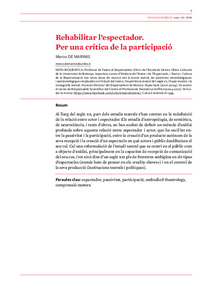Rehabilitar l’espectador. Per una crítica de la participació

Metadata
Show full item record
Estudis escènics: quaderns de l'Institut del Teatre. 2018, Núm. 43
Document typeArticle
Abstract
Al llarg del segle xx, part dels estudis teatrals s’han centrat en la redefinició de la relació entre actor i espectador. Els estudis d’antropologia, de semiòtica, de neurociència, i tants d’altres, no han acabat de definir un mètode d’anàlisi profunda sobre aquesta relació entre espectador i actor, que ha oscil·lat entre la passivitat i la participació, entre la creació d’un producte autònom de la seva recepció i la creació d’un espectacle en què actors i públic desdibuixen el seu rol. Cal una reformulació de l’estudi teatral que se centri en el públic com a objecte d’anàlisi, principalment en la capacitat de recepció de comunicació del seu cos, i tot això dins d’un segle xxi ple de fronteres ambigües en els tipus d’espectacles (només hem de pensar en els «reality shows») i en el control de la seva producció (institucions teatrals i polítiques). Throughout the 20th century, some theatre studies have focused on redefining the relations between actor and audience. The studies of anthropology, semiotics, neuroscience, and so many others, have not fully defined a method of profound analysis of these relations, which have swung between passivity and participation, between the creation of a product independent of its reception and the creation of a production in which actors and audience blur their roles. It is necessary to reformulate theatre studies in order to focus on the spectators as an object of analysis, mainly in their bodies’ ability to receive communication, in a 21st century full of ambiguous borders in types of productions (we only need to think of “reality shows”) and in the control of their production (theatre and political institutions).
Access conditionsOpen Access
ISSN2385-362X
,
0212-3819
Collections
- 2018: Núm.: 43 [15]

